THE LYDIA CRAZE
THE LYDIA CRAZE
By R VELU
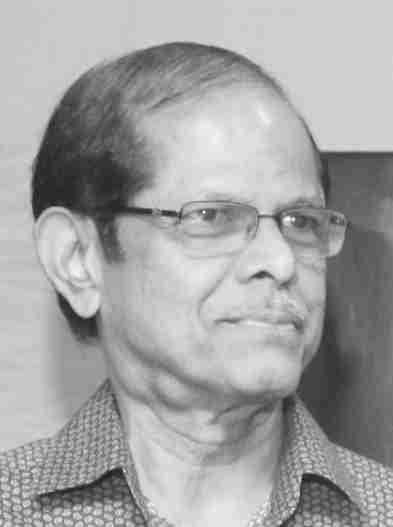
The Marina-mania that gripped the athletics scene in the 1977 SEA Games is a thing of the past. It’s now the Lydia craze. Everywhere you go in Manila, people will go into rhapsodies over this long-legged darling of the track.
Lydia De Vega has been described as having world class promise. And she is set to take over as the new SEA Games queen of the track from Burmese star Than Than. What’s her background? How did she develop her athletic ability? And what does she think of her future? Sports Mirror finds out.
“I want to be world champion,’ said Lydia, standing tiptoe and raising her right hand…. reaching for the sky. “And I want to be an Olympic champion,” she added opening her eyes wide.
“Well” I said, “If you are going to be a world champion, you’ll definitely be an Olympic champion.”
“Not necessarily,” she quickly countered, breaking into a wide grin.
“There have been world champions before who didn’t win any Olympic gold,” she had me there. How many Ron Clarkes, Jim Ryuns…. world record holders had retired without an Olympic gold to their name.
This observation comes from a 17-year-old college student who bursts into girlish giggles at the slightest joke, who’s all arms and movement when trying to describe something vividly, has a simplicity that’s disarming and a charm that’s appealing, rolls her R’s and ‘aahhs’ her A’s with the usual Filipina accent.
Fame hasn’t changed her, say many Filipinos. She is still the simple bright-eyed girl from Barrio Kalbaryo, a thickly populated and poor suburb of metro-Manila, a suburb of closely connected houses muddy pathways where costume jewellery is made and sold.
She’s the girl who developed her running ability by sprinting more than 500 metres to buy cigarettes for her father when she was very young. A girl who used to play ‘Chinese Garter” – a popular street game where a tape or string of rubber band is held up high by two kids and the third takes a flying kick hooks the string down with the right and whips over without the leg touching the string – with such grace and balance that those who saw her said she was a natural.
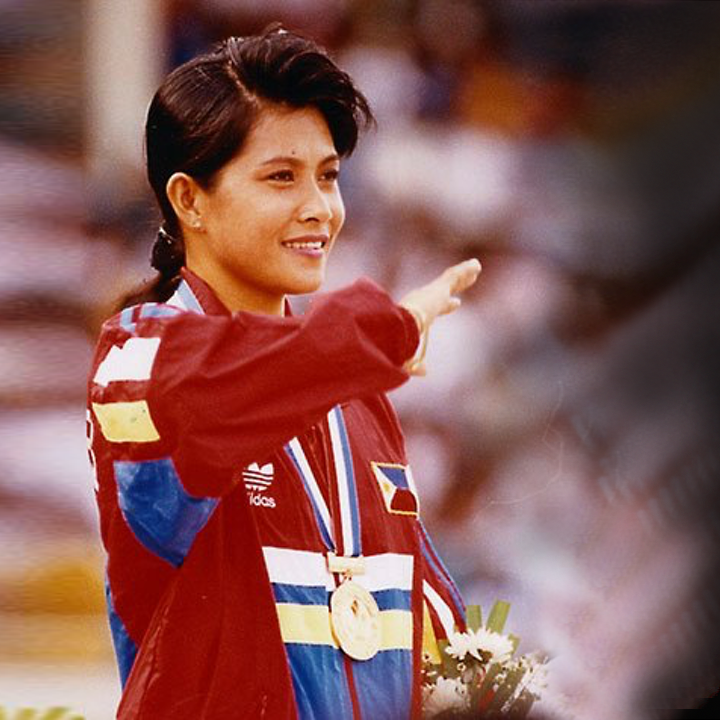
TEMPTATION
It was the game she was playing when we met the other day at the 5,000ft high Gintong Alay athletics training camp in Baguio City. She had finished training in the morning and was dressed casually – light-brown slacks and a yellow T-shirt that had ‘Halloween’ printed boldly in front.
The heptathlon trails were going on and for Lydia, the finishing tape strung between the posts presented a temptation she couldn’t resist. ‘Chinese Garter’. This time she sailed over it straddle style without touching the tape.
Screams of delight and laughter greeted her each time she attempted the jump. And Lydia would respond by pulling funny faces. Watching her, you would hardly guess that this is the girl who is being described as future world class material. She is the uncut diamond in a glittering pile of talented athletes that the Filipinos have brought together.
“Do you know I would play the game to this height even when I was very young,” she said stretching her right hand well above her head and laughed.
What was that? A glitter of silver? A wire hooked to one tooth? False teeth, I reasoned.
“You have false teeth,” I asked, surprised because she seemed to have such a beautiful set. Surprised because she was young and healthy.
“Yes” she cried delightedly with impish humour at my surprise. She lost her front four upper teeth when very young. “Too many sweets and candies. I still like them. I like eating very much, that’s why I’m so fat,” she spread her arms sideways descriptively and wiggled her hips.
Lydia was still running gap-toothed in last year’s national championship. It was only late last year that she received her dentures from her father Francisco, her one-time coach who is now her confidante and masseur.

Just then he came up, right hand in a bandage, and smiled widely. His front four teeth were also missing. “I lost them in a fight,” he explained. He was a boxer in his younger days.
It was in the streets and alleys of Kalbaryo that Lydia developed her talents. When she was just nine, she would run like a hare to buy cigarettes for her father.
It was while playing ‘Chinese Garter’ that Lydia was spotted. When school was over it was the streets and ‘Chinese Garter’ for most of the girls. One school teacher noticed the facile grace and perfect balance with which she executed her jumps.
He asked Lydia to compete in the school sports the following day. She was then just a frail, waif-like 12-year-old. Lydia agreed. But she had to win over her skeptical parents first and that was left to a neighbour who persuaded her parents to let her compete.
Grudgingly, Francisco forked the pesos necessary to buy a new pair of shorts for Lydia. But unconvinced, Francisco did not attend the meet. The only fan Lydia had then was her neighbour who was cheering wildly as Lydia stormed to first place in five events.
Some dust was stirred as an athlete couldn’t compete in more than four events. But Lydia was given her prizes all the same. That finally convinced Francisco that his daughter had some talent after all. He began attending her sports meets and became her first coach and trainer.
Simple, soft-spoken, chain-smoking Francisco has been a controversial figure in Lydia’s athletics career. There is this story of how he slapped Lydia in public when she was training at the Marikina Stadium where she set the national 400 record of 54.6 last year.
Lydia made several foul jumps in the long jump. Francisco, convinced that she was fooling around, gave his daughter two tight slaps in front of the other athletes.
Lydia cried softly …. “It hurt,” she said the other day, rubbing her cheeks. But it worked, and Lydia was more serious and went 5.5-plus metres in her subsequent attempts.
“I have these two hands,” said Francisco, the boxer in him surfacing. “If the right is not enough, then I give the left. But I don’t ill-treat my children. I give them what they want. When Lydia had washed up and was ready to go back that day when I slapped her, she came up to me smiling and asked, ‘Papa. Give me some money.’ I gave her the money. I only discipline my children. Francisco has six children, three boys and three girls. Lydia is the fourth.
There was another incident when an angry Francisco pulled his daughter out from training camp in Baguio because she was being put into the 800 metres. Many coaches, including Asia’s legendary Chi Cheng, believe that it is over the 800 metres that Lydia will make her mark.
Those long legs were meant for the 800 metres, they said. But Francisco would have none of it. She is too young for it now. Maybe when she is older, he said. Attempts to get Lydia back into camp failed and she was suspended for some time last year before the warring parties were reconciled.
Father and daughter enjoy a very close relationship. “He has every right to spank me and decide what’s good for me,” said Lydia. Then a ring on her engagement finger caught my eye.
Is she engaged? “Yes to my father,” she joked. “He made it himself and gave it to me. I wear it always.” Francisco is also an artisan who makes the costume jewellery that one finds in tourist centres in Manila.
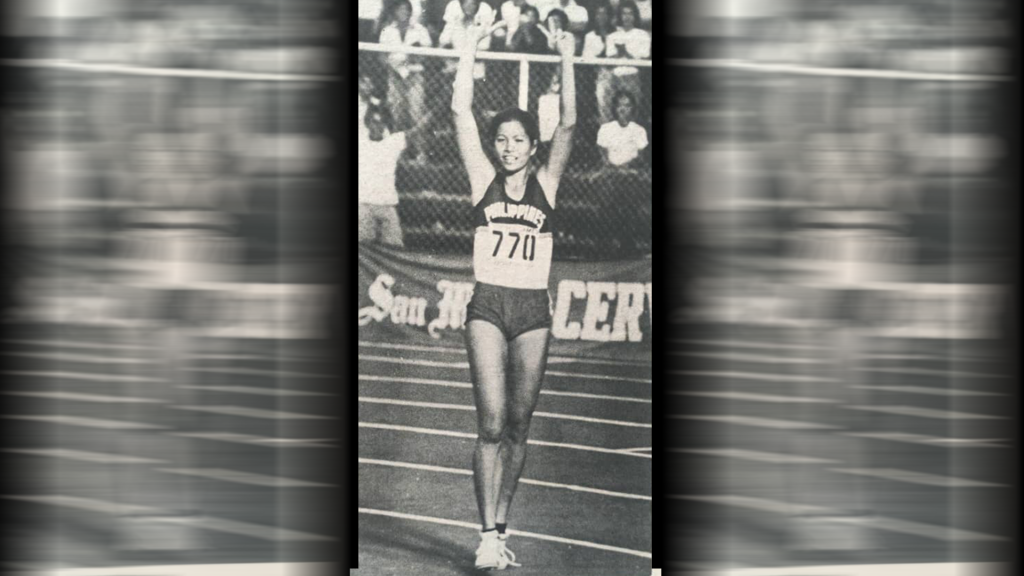
PROMINENCE
It was as a spindly-legged schoolgirl that Lydia swept into prominence by bagging three individual golds and two relay golds at the 1979 Singapore Asean Schools athletics championship. Now Lydia, who turns 16 on December 26th – Boxing Day – has grown in stature and physique.
“I am 5ft 6ins now,” she proclaims proudly, “and weigh 120lbs.” Again, that hip wiggle. “I am a first-year student in college and hope to pass out with a degree in physical education.”
Lydia renews her rivalry with Malaysia’s Mumtaz Jaafar – a rivalry which dates backs to the Singapore Asean Schools meet – in this Manila Sea Games and will attempt to crack the myth of invincibility surrounding Burma’s Than Than who holds the Sea Games 200m, 400m, 800m and 400m hurdles records.
The brown-skinned, dark-eyed Filipina is down for the 200m and 400m where she has a season’s best of 24.0 and 55.2 …. Which make her the brightest gold medal prospect in both events.
Can she win the events? The playful child in Lydia took a backseat. She looked mournfully at her left instep. Her left foot was bandaged. “I really don’t know,” she shook her head. “I injured my foot, you know when I was climbing the stairs back to camp after training in Baguio.
“It’s a bit better now. But I can only hope to do my best. I hear that Mumtaz has done some good times. And Than Than is a very powerful and experienced runner. I can try my best.”
Lydia has been taking it easy during training feeling secure that the two golds are hers, says Gintong Alay head coach Tony Benson. But when she heard that Mumtaz had gone under 12 for the 100m and clocked 24.4 for the 200m, she saw the threat and put in more effort.
Benson agrees that Lydia has world class potential. “She will make a very good 800m runner. She has the speed but will have to build up stamina and endurance and put in more effort,” he says.
Lydia could make an impact in next year’s New Delhi Asian Games. But it is the 1988 Olympics that every athletics follower in The Philippines is waiting for. This is where she is going to make her name known worldwide, they say.
“That’s if some boy doesn’t come along by then and asks her to decide between him and track and field,” quips Nars Padilla, camp commandant at Baguio City, who says that Lydia is a very exemplary athlete.
NOTE: This story appeared in the weekly Sports Mirror (Malaysia) in December 1981 before Lydia de Vega became a “star”.
MIGHTY BEE
By Yong Soo Heong
Ng Boon Bee was already a big name in the badminton world and synonymous with Tan Yee Khan when I was trying to make a mark in the sport in the late 1960s. Their successful partnership with relentless and powerful smashes was always imprinted in my mind.
Somehow, I didn’t make it into ‘Big Time’ because of two primary reasons: my journalism career got in my way (which is a good thing as I look back to those years) and my belief that I could be a good player if I had perfected my strokes well enough.
On this second point, how silly and mistaken I was. The game of badminton necessitates one to have match experience in order to excel as no one player is the same. I fault myself for not listening to my dad in this department. No point crying over spilt milk now, as they say.
Back to Boon Bee. One day at the tender age of 16-going-on-17 in 1971, I found myself in the company of the great man himself and his doubles partner, Punch Gunalan, in Ipoh. I was sent to compete in the Perak Open as the then President and Honorary Secretary of the Penang BA, the late Mr Gan Chin Huat and the late Mr Tan Lee Sin, had always wanted to give young players all the exposure to prove themselves.
Somehow, I lost in the early rounds to better opponents. I wasn’t tenacious enough or out of depth, to be frank. But my legs were already wobbly when I saw the two badminton luminaries listed down to play in the same tournament! I told myself how could I stand a chance when these two greats were around!
In between matches, I “bumped” into them at the Perak government chalet along Jalan Tambun where we were accommodated. I was with some of my senior team-mates from Penang who apparently knew Boon Bee and Punch better, when we saw the pair resting in one of the rooms.
I too made a beeline to see what these two greats had to say as they had months earlier returned triumphantly with the coveted All-England men’s doubles title, beating Rudy Hartono and the late Indra Gunawan (who later went on to coach the Malaysian team).
I peered from the door. Punch was munching on an apple while Boon Bee was relaxing on the bed. We made small talk. Can’t remember what we spoke as it was more my senior team-mates who did most of the talking while I was just a wallflower in the company of our country’s badminton kingpins. It was a scene I can never forget.
Back in those days when there was no “live” television to follow important badminton matches, Radio Malaysia was the only source of exciting sporting action. I would often preen my ears to “live” radio commentaries and follow the blow-by-blow accounts on Radio Malaysia.
Radio Malaysia’s then sports presenter supremo, R. Jeyanathan, was often drumming it into me with his trademark commentaries. I still remember his colorful description which would sound like this: “Boon Bee leaps into the air and smashes, but it is well taken by Indonesia’s Indra Gunawan.
“Boon Bee springs into the air again and smashes but Hartono defends it well. Yee Khan smashes this time, and the shot is returned fast and furious.
“Wow! Boon Bee leaps up and chops the shot into the middle of the court. It catches the Indonesians off-guard and yes!…Malaysia marches forward with another point.”
Boon Bee jumping into the air was always an SOP…standard operating procedure. That was his trademark as he possessed strong muscles in his thighs, which sometimes, to me, looked like that of a powerful frog.
That was why Boon Bee, an ex-pupil of St Michael’s Institution, Ipoh, could excel in many sports because he could either outrun his opponents or be speedy about things.
He was even a prolific footballer representing Malaysia in the Merdeka Football tournaments in 1958 and again in 1959 when Malaysia were champions. This was the premier tournament in Asia from the late 1950s to the late 1970s.
N. Thanabalan, an international footballer, recalls: “I had the privilege of playing alongside Boon Bee for our employers, the National Electricity Board. He was a very good teammate who was jovial and very highly motivated.”
Boon Bee was a very talented sportsman, who also excelled in athletics, rugby, and even tennis at state level.
But it was badminton that propelled him into the world stage and got him the most headlines and accolades.
During his prime in the mid-1960s till the early 1970s, he would travel in a quartet with his doubles partner Yee Khan, Yew Cheng Hoe and Tan Aik Huang as they took on the world.
Boon Bee and Yee Khan developed into a formidable pair, raking in titles after titles wherever they competed.
Yee Khan, who was devastated by the recent death of his doubles partner, said they had built up a formidable combination to be the best men’s doubles pair in the world at one time because of their attitude towards the game.
They had one simple strategy or game plan: always analyzing their opponents game, whether in defeat or victory.
“Whenever we won or lost, we would discuss how we could improve our game and tactics. We would always discuss before the game on what went wrong or what went
right the day before. That was how we adapted well to each other by forging a good understanding on what we should be doing and what we should not do when on the court.”
On how he came to form a triumphant partnership with Boon Bee, Yee Khan says: “I was in Form 4 when I started playing together with Boon Bee. I was from Yuk Choy, a Chinese school, but was subsequently enrolled at St Michael’s Institution where the then Brother Director Pius Kelly asked me to team up with Boon Bee. From there, it was the start of our successful partnership.”
Between 1960 and 1969, both Boon Bee and Yee Khan won some 20 prestigious titles together, including the All-England, US Open, Canadian Open, Denmark Open, Singapore Open, Malaysian Open, Asian Championships, Asian Games and the South-East Asia Peninsula Games.
The pair’s highest distinction was the Malaysian victory in the Thomas Cup in 1967, gained in the teeth of a hostile crowd in Jakarta which was disruptive in behavior aimed at heading off a Malaysian triumph that Yee Khan’s and Boon Bee’s exploits in the doubles guaranteed.
Boon Bee, together with Yee Khan, starred with captain Teh Kew San, Tan Aik Huang, Yew Cheng Hoe and Billy Ng in the team that brought home the prestigious trophy in that series.
The Thomas Cup triumph was the capstone of a decade of distinction for the doubles pair.
Cheng Hoe recalls: He earned my respect as our leader for he was a warm, caring and friendly person. It was always good to talk to him. He would often ask about our well-being during our tours. With him around, it was like family.”
Sylvia Ng, Malaysia’s number one women’s shuttler at one time, also remembers Boon Bee as a friendly person. He proved to be an adaptable partner when he and Sylvia teamed up to capture the 1970 Asian Games mixed-doubles title.
“We got on very well. Boon Bee was always easy to talk to,” she said. ”I shall definitely miss him.”
Both Cheng Hoe and Sylvia agreed that it was Boon Bee’s physical adaptability to emerge as one of Malaysia’s greatest sportsmen as he subsequently found success with the late Gunalan after his regular partner Yee Khan retired from competitive badminton because of a serious head injury. This was after Yee Khan had a fall while jogging during training for the Rangoon (now Yangon) SEAP Games in 1969.
One of Boon Bee’s best performances was with Gunalan in the 1971 All-England final when they defeated Indonesia’s top pair of Rudy Hartono/Indra Gunawan. They also won the Bangkok Asian Games and Commonwealth Games in Edinburgh, both in 1970.
“He was without a doubt not only a great player but the best doubles player during my time,” said Rudy Hartono, the seven-time All England singles champion in Jakarta.
“Rest in eternal peace my dear friend. Bless you.”
Fast forward to late 2019, I was in the company of ex-Uber Cupper Sylvia, former Thomas Cupper Saw Swee Leong and former Asian junior champion, the late Tan Aik Mong. We were on a road trip to look for Boon Bee in Ipoh as Aik Mong said he had lost contact with him for quite a while.
We managed to track him down after going through several phone numbers. It was finally via Boon Bee’s wife, Tong Ee Cheng’s handphone! We met for coffee in a shopping mall. It was a great reunion among those big-time shuttlers and they reminisced about the good old times. Their camaraderie ship was something to behold.
When Swee Leong volunteered to say that I was playing competitive badminton with him as well as the likes of James Selvaraj, Phua Ah Hua and Razif Sidek back in the 1970s, Boon Bee let out a bewildered response: “You must be joking!”
And that came from the man whom I held in awe. I can’t fault him for his sharp reaction or observation for I have ballooned into a 150kg sumo wrestler’s frame.
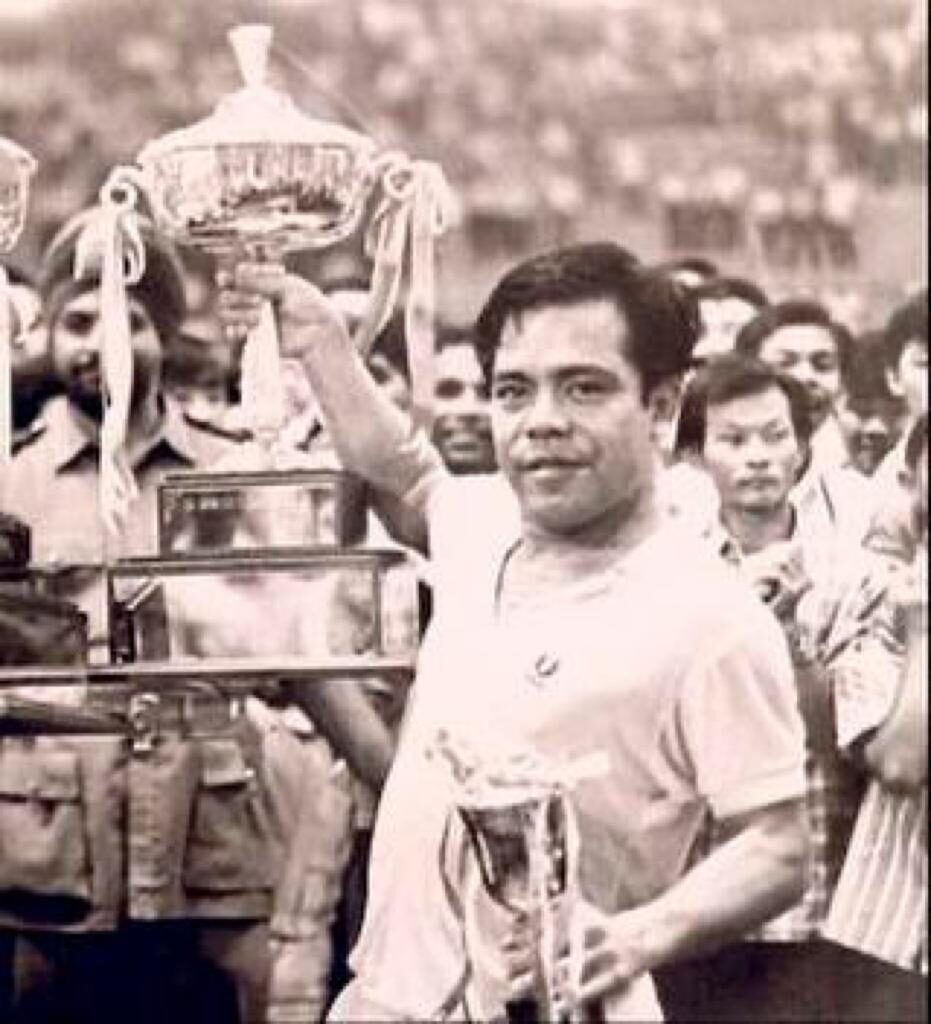
Prabhjot Singh recounts about a player opponents feared.
PENALTY KING PRITHIPAL
He was dubbed the world’s most feared penalty corner specialist
Played in three successive Olympic Games hockey competitions for India.
1960 Rome Olympics — Silver
1964 Tokyo Olympics — GOLD
1968 Mexico Olympics — Bronze
At the Tokyo Olympics he netted eleven of the 22 goals India scored.
After India’s disappointing display in Mexico, Prithipal retired from the sport.
Was born in Nankana Sahib ( now Pakistan) on 28 January 1932 to a school teacher father ( Sadar Wadhawa Singh), who was also an agriculturalist.
He excelled in sports and studies earning himself a Masters in Science degree from the Punjab Agriculture University.
After graduating he joined Punjab Police and had toured Africa and Europe.
On retiring from hockey after the Mexico Olympics, he became the Sports & Student Welfare Director at Punjab Agriculture University.
May 20th 1983 Prithipal was murdered. The killers to date have never been traced.
Prithipal was the first hockey player to be decorated the ARJUNA Award (1961) and the PADMA SHRI Award (1967).
A movie based on his gun biography “PRITHIPAL SINGH”, was released in 2015.
Prithipal…. a forgotten hockey legend.
Remembering “The Flying Singh”
Prabhjot Singh: A veteran Indian sports journalist, recollects the relationship with India’s iconic athlete, Milka Singh.
In 1958 when the then Prime Minister Pt Jawahar Lal Nehru asked Milkha Singh what he wanted for becoming the first Indian to win an individual gold medal in athletics in the Cardiff Commonwealth Games, the ace sprinter requested a “national holiday” in the country. And 63 years later, on Friday night, he himself embarked upon a long holiday leaving not only the entire nation but the whole sporting world sobbing and grieving.
A Tribute to Tony Francis
Mentor to some, dear friend to many, legend to the industry, and prankster to all, Tony Francis was the real McCoy.
Though he has passed on to another realm, he has left an indelible mark on many, who don’t just feel his absence, but also feel the loss of a person who had been many things to different people.
In this tribute, brought to you by Sports Flame, the spirit of Tony Francis, lives on, immortalised by the memories shared by his friends and former colleagues.
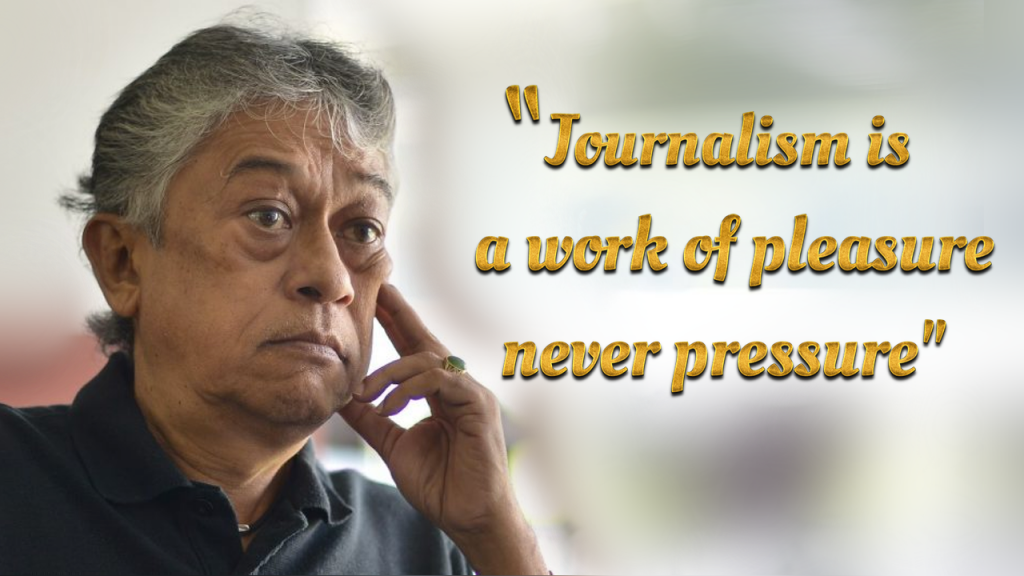
Rookies Searching For Fame
By Kyi Hla Han
It was 1982, my rookie year when I started my professional golf career playing on the Asian Circuit and Australia.
After the Asian Circuit concluded (February to April), I stayed with my brother Chan Han, who was the resident pro at the Royal Johor Country Club in Johor Bahru (Malaysia). I continued playing in some local tournaments in Malaysia until June.
My eldest brother, Stuart Han who lives in Sydney, Australia invited me to come over and play in the Australian Tour later that year.
Together with my new found Malaysian pro friend K Selarus, we packed our gear and travelled to seek our fortune in Australia. We were the only two Asians featured on this tour. We started the Australian Tour with the South Australian Open at the Royal Adelaide Golf Club.
After the first practice round, I returned to the hotel. When Selarus got back, he excitedly told me he had met a golfer who looked very Indian but was from Fiji. And he wanted to join us for the next day’s practice round.
I remember asking Selarus: “Where the hell is Fiji? Never heard of this country.” And both of us had a hearty laugh.
The following day Selarus and I met the tall Fijian who introduced himself as Vijay Singh and we played the practice round together.
We became a trio, travelling together, sharing rooms and playing the Australian Open, New South Wales Open, Victoria Open and Queensland Open.
When there was a break on the Australian Tour, all three of us stayed with my brother Stuart in Sydney.
Vijay told me he was looking for tournaments to compete after the Australian Tour and I invited him to play in Asia. I offered him a place to stay with my brother Chan Han and use Johor Bahru as a base.
That’s how Vijay arrived in Asia in 1983, unknown and struggling like me to eke a living from golf.
At the Royal Johor Country Club, Chan Han got permission for us to practice and use the club golf facilities. We used to practice at the driving range daily and at night Chan Han made us collect the balls from the driving range.
With flashlights in our hands, Vijay and I roamed the range, collecting the balls until 9pm daily. Only after this did we have our dinner. We were up by 6.30am hitting balls, playing 18 holes and hitting balls again until dark.
Even back then Vijay worked very hard on his game and we were grateful to the Johor Golf and Country Club for allowing us the use of their facilities.
When we played tournaments in Malaysia, Thailand and the Philippines, Vijay and I roomed and practiced together.
We were both very young (me 21 and Vijay 20) and raw but very ambitious. We were driven by our dream of playing on the European PGA Tour.
Vijay was serious about golf and I was also like –minded. We had a lot in common. We worked on our game together and had lots of fun.
Vijay was a quiet person but somehow we hit it off from our first meeting. We talked golf all the time. In our spare time we hung out at video game parlours or went to the beach in Desaru, Johor (Malaysia).
I went off to Europe in 1983 and Vijay stayed with my brother Chan Han at the Royal Johor Country Club (Malaysia).
When I returned to Johor Bahru a few months later, I noticed Vijay had improved on his game tremendously.
Chan Han told me that Vijay had worked out on his game for many hours a day. His drives were much longer and his shots were stronger and accurate.
A few years ago when we caught up for dinner during the 2016 US Masters in Augusta, we reminisced about those days of the past. Although those were tough days, they were memorable. We were poor, hungry young golfers dreaming of that big break.
Vijay certainly has come a long way and has proved that he is of world class. I continued on the Asian Tour and won the Asian Oder of Merit No. 1 in 1999.
(Kyi Hla Han is a golf pro from Myanmar and was the former Executive Chairman of the Asian Tour.)
Losing a “New Found” Friend in Aik Mong
By Yong Soo Heong
Shuttler Tan Aik Mong’s sudden demise in the evening of May 31, 2020 was indeed shocking, to say the least, for me.
One of my Penang badminton contemporaries, Lim Teong Khoon, had forewarned fellow members of our group chat to brace for something depressing as he disseminated the information. I sat stunned in my car after receiving the sad news.
Stunned and sad because it was just 10 days earlier that Aik Mong had shown how fighting fit he was by mowing the lawn of his Bukit Jelutong home. Later, he was seen strolling the greens at Kelab Golf Negara Subang for his second favourite game – golf – to the cheers of his many friends and club members.

Aik Mong was well-liked and had many friends as he was a good conversationalist although he may have had some unorthodox ideas on certain issues. He was open, opinionated but yet not offensive.
But as they say, life is unpredictable. And I was devastated to learn that Aik Mong, 70, had finally succumbed to liver cancer which he fought for many years without the aid of chemotherapy on that fateful Sunday as I was beginning to get used to being a good friend to him.
I was comforted that he had Irene Ch’ng, his confidante of 22 years, by his bedside as he breathed his last breath. His son and family in Singapore were affected by the MCO restrictions then in place but they subsequently came in time for the funeral.
Irene had said that Aik Mong knew the end was near about three days before he was to go and did everything to set everything straight. In other words, he had fulfilled what he had set out to do and was able to let go of the material world towards the end. He was at peace with the world.
Earlier, Aik Mong in fact had planned to go to Johor just after Chinese New Year (CNY) with me and two other more accomplished shuttlers, Thomas Cupper Saw Swee Leong and six-time national champion Sylvia Ng . Besides wanting to sample the glorious food in Johor, he had wanted to meet two other badminton legends, Roland Ng and Billy Ng, elder brothers of Sylvia, and also a mutual friend, Albert Goh Teong Hoe, who had built a 19-court badminton complex in Johor Bahru. (Incidentally Roland died a few days later on June 10 at the age of 89).

Ever since Aik Mong left his second Badminton Association of Malaysia (BAM) coaching stint abruptly in 2013, he had always wanted to find ways to contribute towards coaching the young. The Penangite, who was once BAM coaching chairman in the mid-80s, thought he had some interesting ideas to be put across to Teong Hoe in JB.
These thoughts actually germinated last November when the four of us – Aik Mong, Swee Leong, Sylvia and myself – had gone to Penang on a food extravaganza! But the MCO curtailed our movements this year and now Aik Mong, whom we affectionately called “Mahaguru” (Master) because of his deep and profound thoughts, is no more with us.
I had actually “known” (note the inverted commas) Aik Mong since the late 60s. “Known” is actually a safer word for I hadn’t got close to him due to our age gap although we passed each other almost every other day as we cycled to school in opposite directions – me to Westlands Secondary School and him to Methodist Boys School in Penang. He’d always nod his head in my direction. I reckoned he may have seen me practising at the Penang Chinese Girls High School Hall, then one of the nurseries of Penang’s many badminton players.
While I was a small fry, Aik Mong was already in the Big League then as he was a Thomas Cupper and played in the SEAP and Asian Games. He had already wrestled for individual honours with then Indonesian maestros like Muljadi (Ang Tjin Siang) and Iie Sumirat. His best achievements was winning the 1971 Asian championship in Jakarta when he beat then Japanese star, Junji Honma. Three years earlier, he had also beaten Honma for the Asian schoolboys’ title in Tokyo.
In fact, Aik Mong played one of his best matches in the semi-finals of the Singapore Open in April 1969 when he beat Dhamardi (Wong Pek Shen) of Indonesia, who had just won that year’s All England men’s singles title about a month earlier, in a three-game thriller of 14-17, 15-14 and 18-14 lasting 69 minutes! Aik Mong, as a thinking player that he was, was observed to have changed tactics by placing many of his shots far to the baseline to thwart Dhamardi’s fast pace game.
Incidentally Aik Mong also partnered his elder brother, Aik Huang (best known for his 1966 All-England men’s singles triumph in 1966) to gun for honours in the men’s doubles event. As a pair, they had even beaten the top doubles combination comprising the late Punch Gunalan and Ng Boon Bee in the 1972 Singapore Open! In the same year, they had advanced to the final of the Indonesian Open but only to lose to the crack Indonesian pair of Ade Chandra and Christian Hadinata in another three-game thriller.
When Aik Mong was 24 years old and working as a computer analyst for Malaysia Airlines in 1975, he announced his retirement from competitive badminton. In citing his reasons, he said that demands were too great for him and that badminton at the national level was not a part-time thing or a pastime because the game was becoming more scientific and demanded a lot in terms of stamina or fitness, court-craft and strategic thinking.
“You have to do so much training and play to stay at the top. No, I don’t want to play badminton all my life. It’s not my whole life.
“I enjoyed playing badminton because it was good for me and good for my country. But when the demands are so great as they are today and the going is tough, it is no longer a joy to continue playing.
“But somehow I had the satisfaction of being among the respected players in international tournaments. I couldn’t ask for more,” said Aik Mong then.
During the course of my career as a journalist in the 1980s, I had actually stumbled into Aik Mong’s office at Kumpulan Guthrie in Damansara Heights for a news story totally unrelated to badminton. It was for a business story and I was referred to him as he was then the group’s top computer analyst and had been successful in laying the foundation to clinching many top-level computer-based government contracts for his employers.
After a long absence, I got “re-connected” with Aik Mong sometime in 2012 at the annual CNY dinners thrown by Teong Hoe at Restoran Oversea in Jalan Imbi, KL. And Aik Mong was always careful with what he ate because of his medical condition.
Somehow, I got along well with him as I was able to respond to what he had to say, no matter how bizarre or twistingly philosophical the topic may be. In 2015, we got closer as I was involved in the publicity part of a birthday bash for Teh Kew San, skipper of the victorious 1967 Thomas Cup team in Penang. We continued to stay in touch via WhatsApp and we would meet occasionally whenever he had an idea to discuss as I’d happily go along as I had nothing to lose by listening to his interesting insights.
But it was in 2019 when we got really closer as Aik Mong had planned to visit another badminton great, Ng Boon Bee, in Ipoh. Boon Bee was off the radar when he retired from a coaching position at the Royal Ipoh Club. At the same time, we were also going to see Swee Leong as he had bought a gated dwelling in Ipoh and was extolling the virtues of food served in the Perak state capital. For a Penangite to sing praises of Ipoh food, we thought we had to find out.
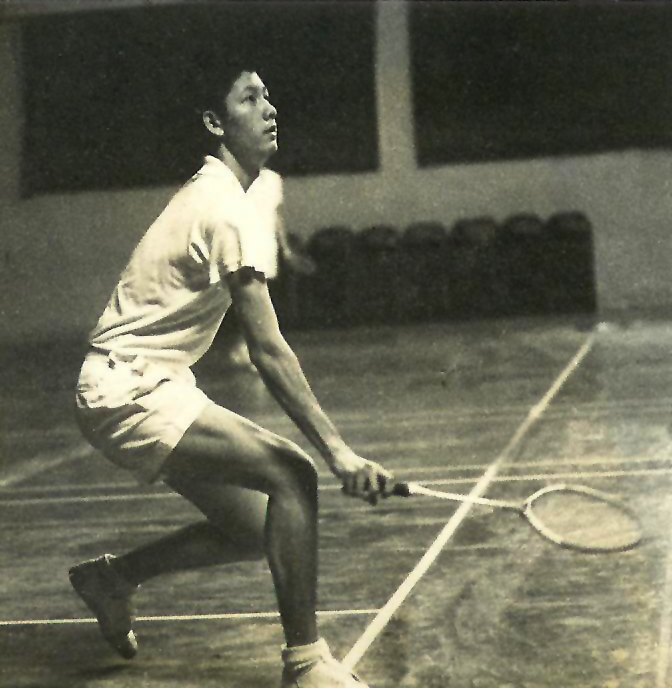
While in Ipoh, Aik Mong tried connecting with Boon Bee from two telephone numbers that he had gotten from another badminton legend, Tan Yee Khan, in Pulau Pangkor, whom he had met about two months earlier. Aik Mong struck gold when the second number was answered by Boon Bee’s wife. And we got connected with Boon Bee at Tesco Ipoh.
An amusing incident happened at the shopping mall. As I momentarily left the group while the former national team-mates caught up with old-time reminisces, it seemed that Boon Bee had asked the trio — Aik Mong, Swee Leong and Sylvia — how on earth did they get associated with a burly guy like me whom he hadn’t known at all. (Like I said, being a small fry in a big pond, I did manage to speak to Boon Bee in Ipoh at the Perak Open in 1972 but how could he, as an already famous player then, remember me, either as a player, fan or human being?)
When told that I used to play competitive badminton with Swee Leong, Boon Bee said they must be joking as I was more suited for sumo wrestling!
They all didn’t tell me this until we were in the car on our way to KL. As Aik Mong related this conversation to me, he guffawed loudly in the trademark style of his father, Cheng Hoe, a noted football and badminton official in Penang in the 1950s and 1960s.
Aik Mong and I got along even better after that Ipoh trip. We would go for occasional lunches and at one instance, we even visited Lee Guan Chong, a noted badminton player and coach from Selangor, when he was hospitalised for a heart attack at PJ’s University Hospital in early November 2019.
Aik Mong, Swee Leong, Sylvia and myself had some of our best times together when we went to Penang later that month. We had travelled on the speedy Electric Train Service (ETS) operated by KTM (Malayan Railway) to Butterworth from KL Sentral and later hopped on a pre-booked taxi that took us to all the popular eating joints in Malaysia’s island food paradise. Aik Mong had joked that I needed to buy two ETS seats in view of my girth. So, two seats were bought in my name but somehow Swee Leong could squeeze in the seat next to me as he came on board from Ipoh to Butterworth. (So I wasn’t that huge after all!)
Upon reaching Penang in the late afternoon, we soon “attacked” a coffee shop in Pulau Tikus known for its sizzling “mamak mee goreng” (Indian Moslem fried egg noodles) and “mee rebus” (egg noodles cooked in spicy gravy) in Bangkok Lane. In the evening, we “cornered” another coffee shop known for “char koay teow” (flattened rice noodles in fish sauce fried with bean sprouts, garlic and prawns), “sotong kangkong” (steamed cuttlefish & water spinach mixed with sweet chilly sauce), “lor bak” (Chinese meat rolls) and other local goodies.
We were again in Pulau Tikus at sunrise for more good stuff – this time for “heh mee’ or prawn noodles (egg and rice noodles, bean sprouts and water spinach cooked in spicy prawn & meat broth) and “apong” (fermented rice pancake cooked with coconut milk) at a popular coffee shop opposite the long-standing police station. Later Aik Mong took us to his secret hideout of a coffee shop at Jalan Cantonment (also in Pulau Tikus) only known to locals for its Chinese-styled “nasi lemak” (rice cooked in coconut milk and served with fried fish & pawns with a dollop of pounded red chillies mixed with prawn paste) as well as “otak-otak” (steamed spicy fish custard wrapped in banana leaves). They certainly brought back memories of yesteryears. Over the next two days, it was the same story – food, food, food.
But of significance was a dinner on Nov 18 where the thoughtfulness and diplomacy of Aik Mong shone through. He had wanted to throw a dinner party that included Kew San, affectionately known as “Ah Peh” (Old Man), among Penang’s close-knit badminton fraternity. Teong Khoon had picked Nov 18. Little did we know that it was also the date of his wedding anniversary.
Aik Mong ordered a cake for the occasion but soon sensed something wasn’t right as it turned out that Teong Khoon’s daughter from his first marriage had also wanted to attend the party. This definitely put Aik Mong in a tight spot.
Amazingly he soon had a brainwave when he discovered that very day was also the birthday of Rosalind Singha Ang, another badminton great who coming all the way from Alor Setar, for the dinner. So, Rosalind got to blow the candles, then Aik Mong also announced that it was also Teong Khoon’s wedding anniversary and asked him to kiss his wife! A sticky situation was averted.
His wry sense of humour and a caring attitude will be sorely missed. Our “fireside chats” at the Jalan Macalister Airbnb late into the night about life in general and badminton specifically turned out to be some of the best times for our reflection. Aik Mong had also spoken of his rather short stint as a coach with BAM, how he had struggled to juggle between his studies and competitive badminton, and how he was living life then.
We did broach on the interesting subject on how the next Malaysian badminton great could be produced. Aik Mong’s views came in a roundabout way as he also spoke of Lee Chong Wei, Malaysia’s star player in the first two decades of the 21st century, and what he had done to achieve fame and glory. Aik Mong conceded that they came with a great price of sacrifice and sheer commitment that included long hours of toil at the gym and on-the-court training.
To put it simply, he was of the firm view that fitness is key to today’s fast-paced game. Without that, a player can’t go far because of the scoring system. We asked him how best one should attain that.
Aik Mong coolly said that if a player could skip 5,000 times a day as part of his or her training regime, then he or she would be on to something. The strokes and strategies can come later. Those words sounded like those of our Penang state schools badminton coach in the 1970s — Lawrence Barbosa!
His confidante Irene recalled that Aik Mong always took on a positive attitude all his life and emphasised that one should always look on the bright side and be happy. For instance, Aik Mong, being the doting grandfather that he was to his grandchildren in Singapore, they would always look forward to his visits because while he was there, there was no curtailment on wi-fi data or gadgets!
Aik Mong also used to say – “live life well and in the most humble way for only God is greater than us. We men are all equals.”
According to Irene, Aik Mong had confided in her that he was concerned for my well-being, especially my weight, as he felt that the demise of my wife, Amy, had affected me somewhat and hoped that I could move on. Such was the kind of concern of Aik Mong for the people he cared for.
I remember one amusing incident when I was sitting alone in a Penang cuisine restaurant in a Petaling Jaya shopping mall and was gorging myself silly over a bowl of spicy noodle soup: Aik Mong spotted me, came over to the open-style restaurant and bellowed from the aisle,”You shouldn’t be eating that!” And he laughingly cautioned me on my food intake.
I shall certainly miss Aik Mong’s sense of humour and his stimulating conversations, especially the cosy “fireside chats”. You were truly a Mahaguru, my friend. Rest well, my champ!
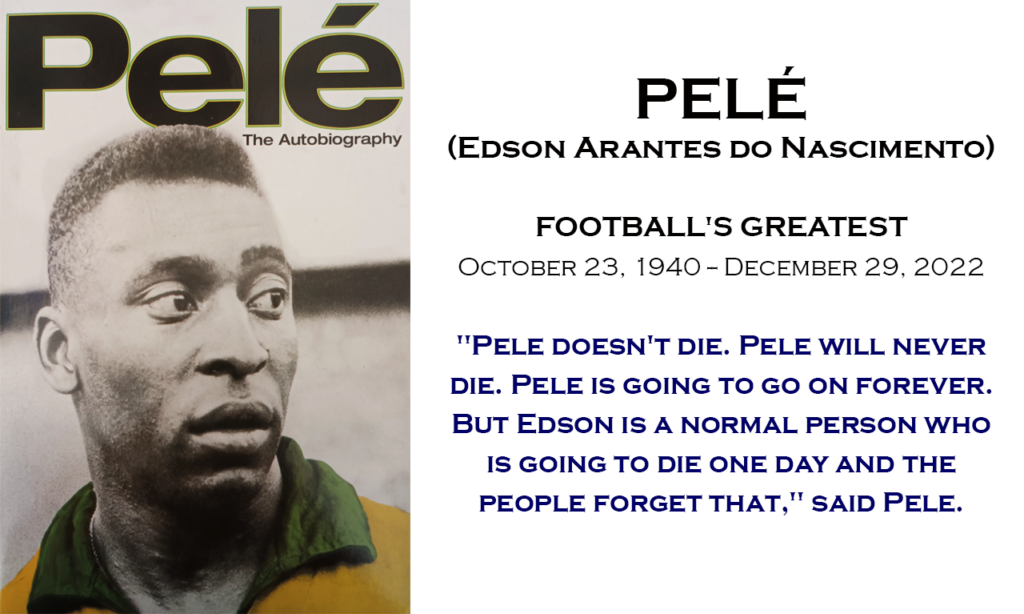
 If you have an interesting personal story of a sports personality with photographs and video, we would like to publish it on this site.
If you have an interesting personal story of a sports personality with photographs and video, we would like to publish it on this site.

